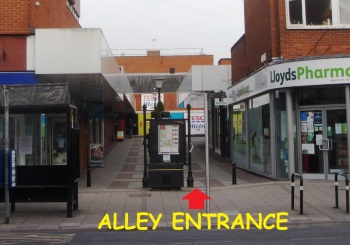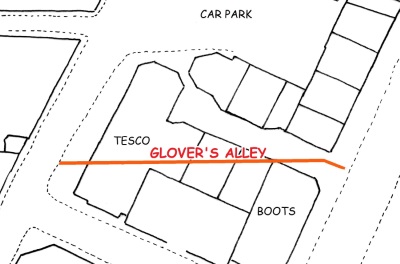Glover’s Alley: A dark and dirty place
The alley had come close to being demolished in 1933 when the erection of a cinema was approved. The company involved wasn’t able to acquire the whole site, though, and it fell through. A rival scheme was more successful, and the Sabrina was built a few yards away, with the demolition of Bishop’s Alley.
The standard of housing in Glover’s Alley did not attract tenants of substance, and it inevitably meant a high level of deprivation, which is reflected in the frequent problems families had there. Some people crop up time and time again. In three months in 1885, for instance, Julia Peart was fined twice for drunkenness, once for using obscene language and then for assaulting Sarah Turley. These were very common sorts of offences in the alley.
Much more serious was the case of John and Minnie Chamberlain, who were each sentenced to fourteen days hard labour in 1922 for child neglect. Doctor Devereaux reported what he found in 4, Glover’s Alley. The room on the ground floor was occupied by a lady known as ‘Black Sall’. The family, all ten of them, lived in two small rooms on the first floor, furnished with just one bed. He wouldn’t use the stairs because four steps were missing and the children had to be brought down to him. He found their heads verminous, their ears dirty and their backs covered all over with flea bites. They were fairly well nourished, though, and there were no signs of starvation or physical violence. Though the family had endured unimaginable ill fortune before finding a roof in Glover’s Alley the magistrates showed little compassion. The children went to the workhouse and their parents to jail.
Glover’s Alley never was, and never could be, a jewel of any sort in Tewkesbury’s crown. It was not a place where anyone chose to live; its residents were there because life had given them little other choice. No-one stayed there for very long. The great majority lived life quietly and on the right side of the law but it’s no real surprise that many didn’t. No-one seems to have mourned the passing of the cottages and eventually the alley itself. Not even the house owners.
to Expand
Glover’s Alley was one of those which were swept away to build the Bishop’s Walk precinct. It was the less-famous neighbour of Double Alley. If you stand in the middle of Bishop’s walk, you are standing at the entrance, with the ‘front house’ of the alley, 89 High Street, occupying the corner of Lloyds Chemists. The alley went diagonally, through the front of Thornton’s to Oldbury Road, at a point opposite the Albion Inn.
Named for Joseph Glover, a carpenter who lived in No 89 in the 1840s, the alley was described as ‘a very old alley and quite of the Tewkesbury style. It is very narrow, about four feet in the widest parts. The houses are very small and in the old time style. They were very dirty and dark and something more like holes in the wall’. The property market seems to bear out this description. In 1880, rents were £2.60p per annum and two cottages were sold; for £9.00 and £12.00. The Borough Council were constantly investigating problems with the condition of houses and regular notices being issued for improvement. By the 1920s, the orders were for eviction, because houses were considered unfit for habitation. These were upgraded to demolition orders when it proved difficult to stop people moving back in. In 1841 there were eleven houses occupied, of thirteen or fourteen in the alley. This number steadily fell and it was almost unoccupied and largely demolished by the late 1930s. Property values fell so low that in 1936 Mr Halling offered his last two cottages to the Council in return for their paying for the demolition. The alley became no more than a pathway to Oldbury Road, and in 1961 an order was made to stop it up, in preparation for the wholesale demolition which would follow a few years later.




Comments